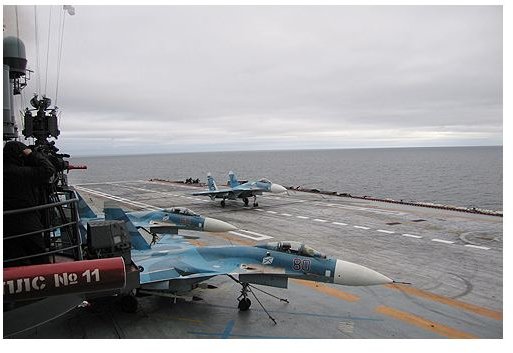Shenyangs J-15: The Future of Chinese Naval Aviation
The J-15: China’s New Naval Fighter
Although the details of Chinese military technology tend to be kept quiet until it is in a fully operational state, most reputable reports assessing the likely operational capabilities of future Chinese aircraft carriers indicate that they will host a fighter aircraft known as the J-15 Flying Shark, constructed by the Shenyang Aircraft Corporation. Given China’s history of adapting foreign designs to suit domestic requirements, it would be unsurprising to see the J-15 be quite similar to the equivalent Russian naval fighter, the SU33 Naval Flanker.
The J-15 fighter is set to be the primary carrier aircraft for the Chinese People’s Liberation Army Navy for some time. With little domestic experience in the production and operation of carrier based aircraft, China seems likely to rely on a proven base design adapted to its requirements rather than strike out on its own to produce a wholly unique aircraft. Although recent Chinese military development has begun to shift towards independently conceived and produced weaponry, such as the new Chinese stealth fighter only recently tested, for some years it can be expected that China will rely on a design borrowing heavily if not entirely from the SU33 - which itself is derived from the highly successful SU-27 Flanker.
The Flanker Family Evolution: SU-27 to SU-33.
The SU-27 Flanker began its development as an answer to the F-15 Eagle, later to be one of the United States’ most successful fighter aircraft. In line with Soviet technological limitations, the SU-27 was intended to counter the F-15’s advanced radar and electronics suite with high maneuverability and close coordination with surface to air missiles and other aircraft like the Mig-29 Fulcrum. Exercises held between the US and India, which operates an upgraded Flanker variant known as the SU-30, indicate that the design is largely successful where it intended to be - the Flanker fighters are extremely acrobatic and nimble, and have been successfully used in several conflicts since the end of the Cold War.
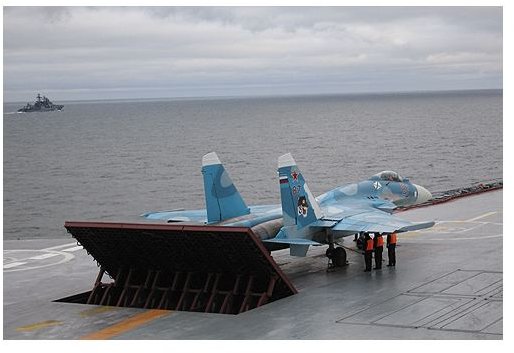
The Flanker’s success and general adaptability made its airframe an ideal choice for operating from then-building Soviet aircraft carriers. Even as the Soviet Union split apart, the SU33 continued development and entered service in the 1990’s on Russia’s sole carrier, the Admiral Kuznetsov.
China is rapidly building its military capabilities in order to be able to effectively defend its territory from modern militaries, and it is in effect rushing to deploy ships and aircraft that are of first-class quality. As such, in light of Chinese designers’ inexperience with producing carrier based aircraft, it is not a surpise to find that they sought to buy the SU33 Flanker in the past, and when rebuffed, appear to have turned to reverse engineering the design based on a prototype purchased from the Ukraine.
Role of the J-15 Fighter: Extending China’s Air Umbrella Over the Fleet
The choice of using the SU-33 as its basis for developing the J-15 is likely rooted in China’s objectives at sea. It will be a very long time before China can reasonably hope to challenge US Navy supercarriers in the middle of the Pacific, and such a confrontation is even in the long term unlikely as China is primarily a continental power concerned with protecting its coastline and a few vital shipping areas such as the Straits of Malacca, South China Sea, and Indian Ocean. Most of these areas are already within range of long range bombers, but fighter aircraft vital to these bombers’ survival in a combat situation tend to have far shorter ranges.
China most likely wants a proven air superiority fighter that can extend the protective air defense umbrella provided by fighters far out to sea, in order to operate in conjunction with land based strike aircraft. The SU33 is an ideal basis for the J-15 fighter in this regard, as the Flanker is an air superiority heavyweight likely equivalent in capability to the F-18E Super Hornets operated by US aircraft carriers and the Rafale flown by the French navy. It is almost certainly superior to the Mig-29 variants expected to be operated by Indian aircraft carriers for some time.
The Chinese J-15 Fighter - Complete Copy of the SU33?
The degree to which the J-15 will actually mimic the SU33 is unknown, but its capabilities relative to its spiritual parent will become more clear as the reconstruction of the Varyag is finished and the Chinese aircraft carriers now under construction get closer to completion. The SU33 is launched from the Russian Kuznetsov with the aid of an angled ski jump at the front end of the flight deck, which allows fighters to take off without aid of a catapult - at the cost of takeoff weight.
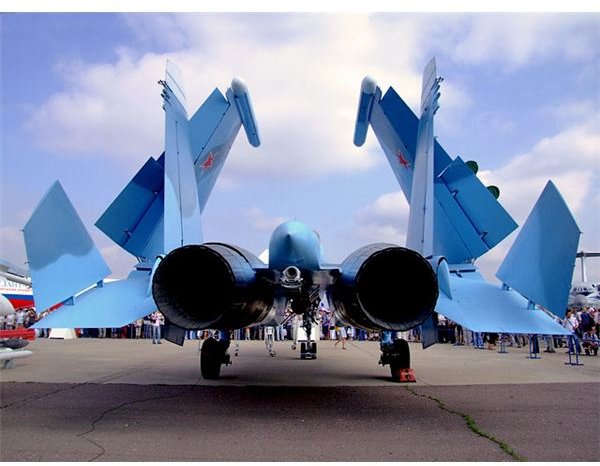
China may or may not maintain this method of launching its fighters. New aircraft carriers under construction in the United States and Britain make full use of catapult launch systems and not ski-jump decks, and if China dispenses with this means of launching aircraft it will mean that the J-15 has been redesigned from the base SU33 to better withstand the stresses of catapult assisted launches. The reconstruction required might also translate to a heavier aircraft better able to launch air to ground ordnance such as anti-ship missiles, which could in turn indicate that the J-15 will be a more multi-role oriented aircraft as opposed to being primarily an air superiority fighter - more akin to the US operated F-18E Hornet than the Russian SU-33 Flanker.
Estimated J-15 Specifications Based on Published SU33 Specs
Again, until the Chinese carriers are launched with or without catapult launch systems or China makes certain aspects of the J-15 design known, the exact
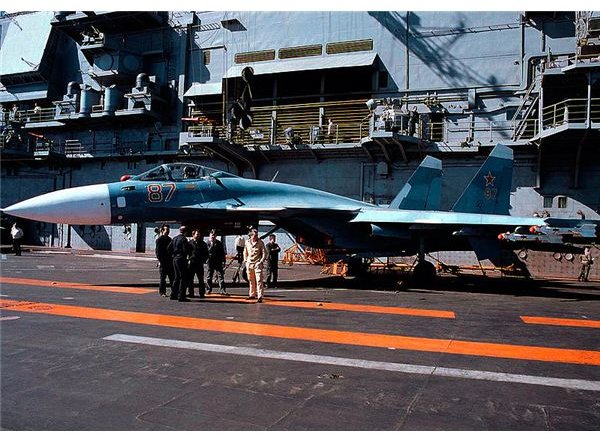
dimensions and capabilities of the J-15 will remain a bit of a mystery. But assuming that the majority of reports are correct and that the SU-33 is the base design, the SU33 Flanker specifications can be used as a baseline for the Chinese derivative:
- 70+ feet long, 20 feet high, 50 ft wingspan, loaded weight of 33 tons
- 2 Afterburner equipped engines with a top speed of Mach 2.1+
- Range of around 1800 miles with an air-to air combat load and 1 pilot
- Around 100 lb per square foot wing loading and 55,000 foot service ceiling
- Internal cannon plus twelve hardpoints carrying seven tons of ordnance
- Ability to launch 4 radar guided and IR seeking air to air missiles
- Air to Surface ordnance, possibly including anti-ship missiles and precision guided munitions, in addition to anti-radiation missiles for the suppression of air defenses and unguided bombs and rockets
Again, these are the baseline stats of the SU33 from which the J-15 is expected to be derived. If the Chinese move to catapult launch systems then the J-15 could be significantly heavier and possibly less maneuverable.
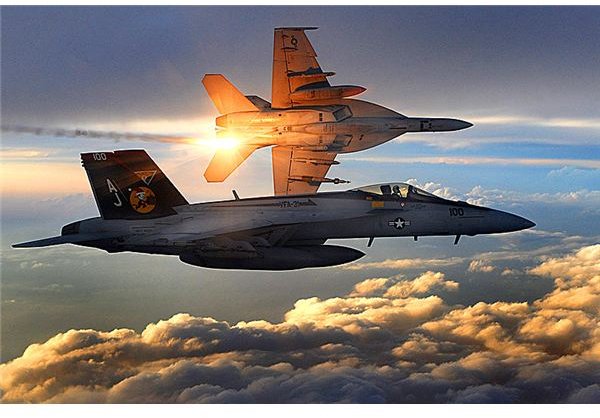
Installing different engines would also raise or lower the top speed depending on their quality. If the J-15 is extremely close in performance to the Naval Flanker, it would be larger than the primary US Navy fighter, the F-18E Super Hornet, and have a longer range and higher top speed, but be just about as maneuverable and less capable in the air to ground role.
Shenyang J-15 Fighter Sources and Image Credits
Sources:
Andy Lightbody, Joe Poyer, Major Dick Cole; The Great Book of Fighter Planes, 1990 Beekman House ISBN 0517035987
China Copies SU-27 Fighter, May Compete With Russia
Is China Stealing Russia’s SU-33?
Sukhoi KNAAPO: SU-33
Images courtesy of the Office of the President of the Russian Federation, Simm, the US Navy, the US Air Force - all via Wiki Commons
